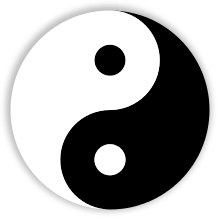Three Treasures (traditional Chinese medicine)
| Part of a series on |
| Taoism |
|---|
 |
|
Deities |
|
Holy places |
|
Organisations |
| Portal Taoism |
The Three Treasures or Three Jewels (Chinese: 三寶; pinyin: sānbǎo; Wade–Giles: san-pao) are theoretical cornerstones in traditional Chinese medicine and practices such as Neidan, Qigong, and T'ai chi. They are also known as Jing Qi Shen (Chinese: 精氣神; pinyin: jīng-qì-shén; Wade–Giles: ching ch'i shen; "essence, qi, and spirit"). Despeux summarizes.
Jing, qi, and shen are three of the main notions shared by Taoism and Chinese culture alike. They are often referred to as the Three Treasures (sanbao 三寶), an expression that immediately reveals their importance and the close connection among them. The ideas and practices associated with each term, and with the three terms as a whole, are complex and vary considerably in different contexts and historical periods. (2008:562)
This Chinese name sanbao originally referred to the Taoist "Three Treasures" (from Tao Te Ching 67, tr. Waley 1958:225, "pity", "frugality", and "refusal to be 'foremost of all things under heaven'") and subsequently translated the Buddhist Three Jewels (Buddha, Dharma, and Sangha).
In long-established Chinese traditions, the "Three Treasures" are the essential energies sustaining human life:
- Jing 精 "nutritive essence, essence; refined, perfected; extract; spirit, demon; sperm, seed"
- Qi 氣 "vitality, energy, force; air, vapor; breath; spirit, vigor; attitude"
- Shen 神 "spirit; soul, mind; god, deity; supernatural being"
This jing-qi-shen ordering is more commonly used than the variants qi-jing-shen and shen-qi-jing.
In Neidan "internal alchemy" practice (Despeux 2008:563), transmuting the Three Treasures is expressed through the phrases lianjing huaqi 鍊精化氣 "refining essence into breath", lianqi huashen 鍊氣化神 "refining breath into spirit", and lianshen huanxu 鍊神還虛 "refining spirit and reverting to Emptiness". Both Neidan and Neo-Confucianism (Despeux 2008:564-5) distinguish the three between xiantian 先天 "prior to heaven" and houtian 後天 "posterior to heaven", referring to Yuanjing 元精 "Original Essence", Yuanqi 元氣 "Original Breath", and yuanshen 元神 "Original Spirit".
The (2nd century BCE) Huainanzi refers to qi and shen with xing 形 "form; shape; body".
The bodily form [xing] is the residence of life; the qi fills this life while shen controls it. If either of them loses their proper position, they will all come to harm. (1, tr. Englehart 2000:99)
The Taoist text Gaoshang yuhuang xinyin jing (高上玉皇心印經, "Mind-Seal Scripture of the Exalted Jade Sovereign", or Xinyin jing "Mind-Seal Scripture") is a valuable early source about the Three Treasures (tr. Olson 1993).
Probably dating from the Southern Song dynasty (1127-1279), this anonymous text presents a simple and concise discussion of internal alchemy (neidan 內丹). In particular, it emphasizes the so-called Three Treasures (sanbao 三寶), namely, vital essence (jing 精), subtle breath (qi 氣), and spirit (shen 神). (Komjathy 2004:29)
Frederic H. Balfour's (1880:380-381) brief essay about the Xinyin jing ("The Imprint of the Heart") contains the earliest known Western reference to the Three Treasures: "There are three degrees of Supreme Elixir – the Spirit, the Breath, and the Essential Vigour".
The (late 16th century) Journey to the West novel provides a more recent example when an enlightened Taoist patriarch instructs Sun Wukong "Monkey" with a poem that begins:
Know well this secret formula wondrous and true: Spare and nurse the vital forces, this and nothing else. All power resides in the semen [jing], the breath [qi], and the spirit [shen]; Guard these with care, securely, lest there be a leak. Lest there be a leak!
Keep within the body! (tr. Yu 1977:88)
References
- Balfour, Frederic H. 1880. "Three Brief Essays", The China Review 9: 380-382.
- Despeux, Catherine. 2008. "Jing, qi, shen; 精 氣 神; essence, pneuma (breath, energy, vital force), spirit", in The Encyclopedia of Taoism, ed. Fabrizio Pregadio, pp. 562–5. Routledge.
- Engelhardt, Ute. 2000. "Longevity Techniques and Chinese Medicine," in Daoism Handbook, ed. Livia Kohn, pp. 74–108. Brill.
- Komjathy, Louis. 2004. Daoist Texts in Translation.
- Olson, Stuart Alve. 1993. The Jade Emperor’s Mind Seal Classic: A Taoist Guide to Health, Longevity, and Immortality. St. Paul: Dragon Door Publications.
- Waley, Arthur. 1958. The Way and Its Power: A Study of the Tao Te Ching and Its Place in Chinese Thought. Grove Press. ISBN 0802150853
- Wang, Mu. Foundations of Internal Alchemy: The Taoist Practice of Neidan. Golden Elixir Press, 2011. ISBN 9780984308255.
- Yu, Anthony, tr. 1977. The Journey to the West. University of Chicago Press.
External links
- Essential Matter, Vital Breath, and Spirit, Taoist Culture & Information Centre
- THE 3 TREASURES OF LIFE: Jing/Qi/Shen, Frances Gander